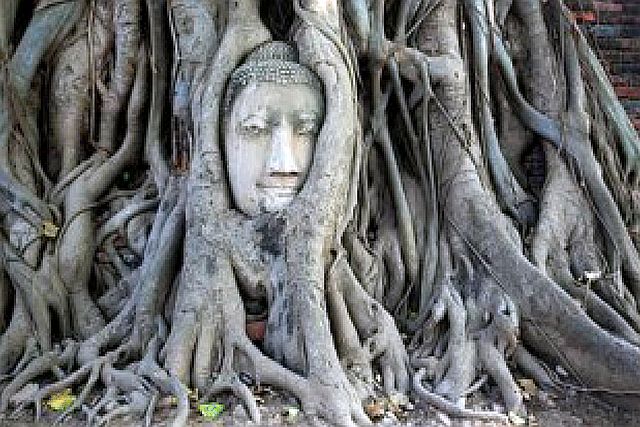 |
| Three Wats in Ayutthaya, Thailand, the country's ancient capital (Courtesy: Tourist Authority of Thailand) |
To the
people of Thailand , the
ancient city of Ayutthaya Thailand
Located
just over 50 miles from Bangkok , travelers can access
Ayutthaya by train, car or taxi but another
pleasant method is by boat along the Chao
Phraya River
 |
| Sitting Buddhas at Ayutthaya (Courtesy: Tourist Authority of Thailand) |
Here riverboats
glide silently along Thailand
Founded
in 1350, Ayutthaya was the second major capital
of Siam Ayutthaya
As a
center of commerce, Ayutthaya attracted trade
from Europe as well as Asia . Traders went in search
of luxurious materials and Thai rice which, at the time, was recognized as the
ultimate commodity of its type in a category all its own much like the standards
set by Beluga caviar and Dom Perignon champagne today.
 |
| Early center of Thai commerce (Courtesy: Tourist Authority of Thailand) |
Thanks
to its strategic geographical position, Ayutthaya
flourished as and island surrounded by three rivers that linked it to the Gulf of Thailand Ayutthaya
Designated
as a UNESCO World Heritage Site in 1991, Ayutthaya ,
with its close proximity to Bangkok
 |
| UNESCO World Heritage Site --1991 Wat-Yai-Chai-Mongkhon (Courtesy: Tourism Authority of Thailand) |
Among
the most popular, and best preserved, temples in Ayutthaya
Here you
will encounter row upon row of Buddha images done in the Sukothai style. Wat
Yai Chai Mongkon gets its importance in Thai Buddhism because it was the
monastery of the monks who journeyed to Ceylon
 |
| Reclining Buddha - Wat Yai Chai Mongkon (Courtesy: Tourist Authority of Thailand) |
Note
that chedi and stupa, are used interchangeably to denote a mound-like structure
used as a place of meditation containing relics that typically contain remains
of Buddhist monks or nuns.
Though
generally unfamiliar to visitors, especially from the West, Buddhas are
typically posed in either a sitting or a reclining position. Look closely
however, for it is the poses and gestures of the statues that give them their
significance.
 |
| A Buddha's pose is important (Courtesy: Tourist Authority of Thailand) |
Each mudra
or "pose" represents a particular event in the life of the Buddha
with five specific depictions being among the most common.
 |
| Buddha's final hours (Courtesy: Tourism Authority of Thailand) |
Often
travelers will encounter a "reclining Buddha" which is another mudra
representing Buddha during his last hours signifying his tranquility and
detachment from worldly desires before passing to Nirvana. As with other
Buddhas, a reclining Buddha, though more rare than its sitting counterpart, also
featuresspecific gestures and poses that are meaningful.
A great example
of a reclining Buddha in Ayutthaya
The word
wat basically translates to "Buddhist or Hindu temple" in Cambodia , Laos
and Thailand
Among
the most famous temples at Ayutthaya
 |
| Wat-Chaiwatthanaram was the site of royal ceremonies (Courtesy: Tourism Authority of Thailand) |
King Naresuan the Great (1555 –1605), one of
 |
| Plenty of souvenirs (Courtesy: Tourist Authority of Thailand) |
Though
badly damaged in 1767 after the fall of Ayutthaya Temple of the Emerald Buddha in Bangkok
Finally,
there is little doubt that the most famous, and most photographed, Buddha image
is Wat Maha That in which a carved Buddha head has become enshrined within the trunk
of Bhodi tree as an eternal tribute to
its surroundings.
 |
| Wat Maha That is the most photographed Buddha at Ayutthaya (Courtesy: Tourist Authority of Thailand) |
Living
proof that a visit to Ayutthaya ,
Thailand







0 comments:
Post a Comment